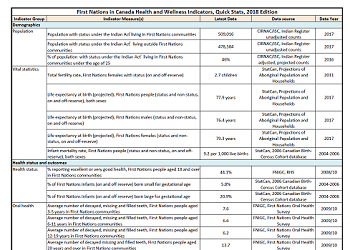First Nations and Inuit Health and Wellness Indicators
The First Nations and Inuit Health and Wellness Indicators provide an overview of some key facets of the health of First Nations people and Inuit. These indicators are grouped into four domains - demographics, health status and outcomes, determinants of health, and health system performance. In addition to each indicator, some interpretive text is provided.
For a quick overview of the indicators, click on any of the four domains below. A list of all indicators within the domain will be displayed. Additionally, a detailed description of each can be obtained by clicking on the “Description” link next to each indicator. The most recent version of the FNIHB Quick Stats is also available in a printer-friendly format.
The Constitution recognizes three main groups of Indigenous peoples in Canada: First Nations, Métis and Inuit. Data for these groups are also available from the Public Health Agency’s Health Inequalities Data Tool edition 2017 on the Public Health Infobase website. Data from the First Nations and Inuit Health and Wellness Indicators are not comparable with data for similar indicators in the Health Inequalities Data Tool edition 2017 because different data sources, populations and methodologies have been used.
- Most data here are for the First Nations population living on-reserve. Similarly, Inuit data are not comparable because for the most part, data here are for Inuit living in Inuit Nunangat, the Inuit homelandFootnote 1.
- Survey-based First Nations and Inuit Health and Wellness Indicators are largely populated with data from the First Nations Regional Health Survey (RHS) and the Aboriginal Peoples Survey (APS).
- Some First Nations and Inuit Health and Wellness Indicators are populated with group-specific data from record linkages. Record linkages bring together information from two or more data sources to create one richer, more detailed database.

First Nations Quick Stats (.pdf) are also available in a printer-friendly format

Inuit Quick Stats (.pdf) are also available in a printer-friendly format
Quick Stats Overview
For more information about each indicator, click on the domains below:
Notes
Abbreviations
- APS, Aboriginal Peoples Survey; CIRNAC/ISC, Crown-Indigenous Relations and Northern Affairs Canada and Indigenous Services Canada; CTBRS, Canadian Tuberculosis Reporting System; DAD, Discharge Abstract Database; FNIHB, First Nations and Inuit Health Branch; FNIGC, First Nations Information Governance Centre; HICPS, Health Information and Claims Processing Services System; PHAC, Public Health Agency of Canada; RHS, Regional Health Survey; StatCan, Statistics Canada
Notes
- Inuit Nunangat includes the Inuvialuit Settlement Region in the Northwest Territories, the territory of Nunavut, Nunavik in northern Quebec and Nunatsiavut in northern Labrador.
- While most people registered under the Indian Act are First Nations people, a small proportion do not identify as First Nations but have status nonetheless; this includes non-First Nations women who gained status through marriage (before 1985), some non-First Nations children who gained status through adoption, and others. This number also excludes those who identify as First Nations but who are not registered.
- Data for Inuit may not be comparable with data for similar indicators in the Public Health Infobase because of different data sources and methodologies. Data in this sheet are primarily for Inuit living in Inuit Nunangat.
- aData for 46,000 Inuit are included with those for First Nations people. These Inuit comprise 5% of the total.
- Data for First Nations people may not be comparable with data for similar indicators in the Public Health Infobase because of different data sources and methodologies. Data in this sheet are primarily for the First Nations population living on-reserve.
- The terms 'on-reserve' and 'First Nations community' used interchangeably, depending on the source of the data.
- Suggested citation: First Nations and Inuit Health Branch, Indigenous Services Canada, First Nations and Inuit in Canada Health and Wellness Indicators, Quick Stats, 2018 Edition
- For questions or comments, please contact BranchStats_FNIHB_SPPI-StatDirGen_DGSPNI_PSPI@hc-sc.gc.ca